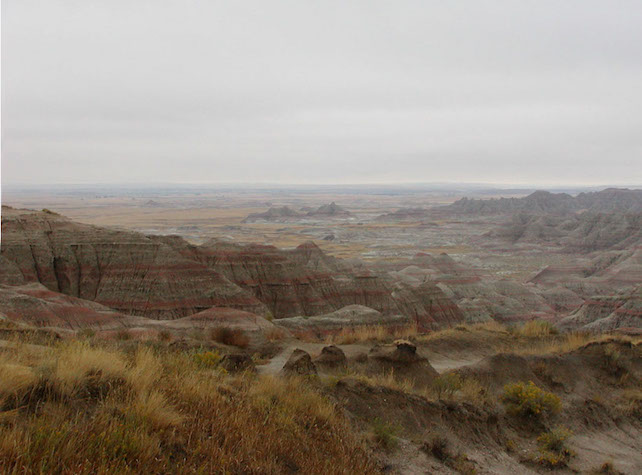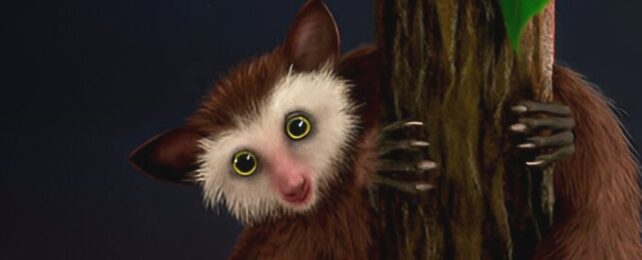A mysterious primate appeared in North America 30 million years ago, long after the continent's native primates had died out, and even longer before the next big influx of primates – humans – would arrive.
This lemur-like species, named Ekgmowechashala, has long puzzled paleontologists. Was it the last holdout of North American primates, or did it migrate from somewhere else? And how did it survive conditions that wiped out the continent's other primates 4 million years earlier?
There's still a lot we don't know, but according to a new study, we finally have fresh clues – including possible evidence about Ekgmowechashala's origins.
Researchers have been aware of Ekgmowechashala since the 1960s, explains paleontologist and lead author Kathleen Rust from the University of Kansas. Yet our knowledge is based on meager fossil remains, mostly teeth and jaws. Those few fossils are "very distinctive," Rust notes, fueling both fascination and frustration among researchers.
"Due to its unique morphology and its representation only by dental remains, its place on the mammalian evolutionary tree has been a subject of contention and debate," Rust says.
Experts now generally agree Ekgmowechashala was a primate, she adds, but plenty of questions remain. The timing and manner of its emergence in North America, for example, is "quite unusual."
"It appears suddenly in the fossil record of the Great Plains more than 4 million years after the extinction of all other North American primates," Rust says.
Primates first appearance in North America's fossil record coincides with the dawn of the Eocene epoch around 56 million years ago, around the same time as their emergence in Asia and Europe.
They thrived in North America for more than 20 million years, explains University of Kansas paleontologist Chris Beard. But that changed about 34 million years ago, he says, as the Eocene gave way to cooler, drier climates of the Oligocene, leading to the extinction of North America's native primates.
"Several million years later, Ekgmowechashala shows up like a drifting gunslinger in a Western movie, only to be a flash in the pan as far as the long trajectory of evolution is concerned," Beard says.

In search of context, the researchers retraced Ekgmowechashala's family tree – a quest aided by the discovery of an even older "sister taxon" from China.
Named Palaeohodites (meaning ancient wanderer), the Chinese fossil resolves how Ekgmowechashala ended up in North America, according to the new study. It was an immigrant, researchers say, not a straggler from the continent's once-prosperous primate community.
"Our analysis dispels the idea that Ekgmowechashala is a relic or survivor of earlier primates in North America," Rust says. "Instead, it was an immigrant species that evolved in Asia and migrated to North America during a surprisingly cool period, most likely via Beringia."
Beard was among the scientists who found the fossils resembling Ekgmowechashala in the 1990s while working at the Nadu Formation in Guangxi, China. Because these ancient primates were so unique, he says, the significance was immediately apparent.
"When we were working there, we had absolutely no idea that we would find an animal that was closely related to this bizarre primate from North America, but literally as soon as I picked up the jaw and saw it, I thought, 'Wow, this is it,'" Beard says.
The Palaeohodites fossil looks similar to Ekgmowechashala's distinctive upper molar, he says, but more analysis was needed. That's where Rust came in.
"We collected a substantial amount of morphological data to create an evolutionary tree using a phylogenetic reconstruction software and algorithm," Rust says.
The resulting family tree "suggests a close evolutionary relationship between North American Ekgmowechashala and Palaeohodites from China," she adds. "The results from our analysis unequivocally support this hypothesis."
Ekgmowechashala likely immigrated from Asia to North America on the Bering land bridge – one of the routes humans may have used to reach the Americas some 25 million years after Ekgmowechashala died out.
While Ekgmowechashala and earlier North American primates faced naturally-occurring climate changes, their story may still offer valuable insights for humanity's modern struggle with self-inflicted climate change, Rust says.
"It's crucial to comprehend how past biota reacted to such shifts," she says, noting that "organisms typically either adapt by retreating to more hospitable regions with available resources or face extinction."
About 34 million years ago, North American climates changed too quickly for native primates to adapt. "This underscores the significance of accessible resources for our non-human primate relatives during times of drastic climatic change," Rust says.
"Understanding this narrative is not only humbling, but also helps us appreciate the depth and complexity of the dynamic planet we inhabit," she adds. "It allows us to grasp the intricate workings of nature, the power of evolution in giving rise to life, and the influence of environmental factors."
The study was published in the Journal of Human Evolution.
